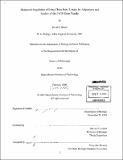Hormonal regulation of long chain fatty uptake by adipocytes and studies of FATP gene family
Author(s)
Hirsch, David J
DownloadFull printable version (14.91Mb)
Other Contributors
Massachusetts Institute of Technology. Dept. of Biology.
Advisor
Harvey F. Lodish.
Terms of use
Metadata
Show full item recordAbstract
Long chain fatty acids (LCFA) are an important source of energy for most organisms. Serum fatty acid (FA) levels are dynamically regulated by hormones. We show that insulin directly stimulates adipocyte fatty acid influx suggesting that the decrease in serum FA levels seen after meals is partially mediated by an insulin-stimulated increase in FA uptake by adipocytes. We also find that TNF-ax directly inhibits FA uptake by 3T3-L1 adipocytes providing a physiologic link between the increased serum levels of TNF-oa and FA seen in Type II diabetes. Transport of LCFA across the plasma membrane is facilitated by FATP, a plasma membrane protein that increases LCFA uptake when expressed in cultured mammalian cells (Schaffer and Lodish, 1994). We report the identification of family of evolutionarily conserved FATPs. In addition to the gene first isolated by Schaffer and Lodish, humans have five additional FATP homologues (designated FATP1-5). All of the mammalian FATPs increase fatty acid uptake when overexpressed in COS cells. FATPs are also found in such diverse organisms as F. rubripes, C. elegans, D. melanogaster, S. cerevisiae, and M. tuberculosis. The function of the FATP gene family is conserved throughout evolution as the C. elegans and mycobacterial FATPs facilitate LCFA uptake when over-expressed in COS cells or E. coli, respectively. Among the mammalian FATPs, several are expressed in a highly tissue specific manner. We show that FATP4 is expressed at high levels on the apical side of mature enterocytes in the small intestine. Furthermore, reduction of FATP4 expression in primary enterocytes by anti-sense oligonucleotides inhibits FA uptake by 50% suggesting that FATP4 is the principal fatty acid transporter in enterocytes. FATP5 is expressed only in adult liver. We have isolated the FATP5 promoter and find that tissue specific expression can be recapitulated in vitro and requires a single GC box in conjunction with two novel ten nucleotide motifs. Additional study of the FATP gene family may provide a better understanding of the mechanisms whereby LCFAs traverse the lipid bilayer as well as yield insight into the control of energy homeostasis and its dysregulation in diseases such as diabetes and obesity.
Description
Thesis (Ph.D.)--Massachusetts Institute of Technology, Dept. of Biology, June 2001. Includes bibliographical references.
Date issued
2001Department
Massachusetts Institute of Technology. Department of BiologyPublisher
Massachusetts Institute of Technology
Keywords
Biology.